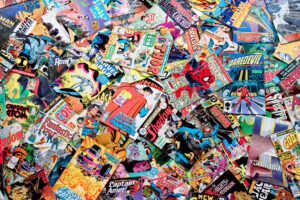Phonogram: The Singles Club #1 (of 7) — Writer: Kieron Gillen; Art: Jamie McKelvie
The first Phonogram had a story whose intentions never quite got matched by its execution, but it was a noble, interesting effort with a clear and appealing voice; the after-essays by Gillen, about writing and about British pop music of the last 20 years, made the books worth keeping. Here, both he and McKelvie have a narrower narrative focus, and they’re assured enough to tell a good one-issue, character-driven part of a larger story. Nicely done, and there’s another essay about British pop, too, one that’ll drive you to iTunes (or more shadowy sites), in search of obscure Pipettes singles.
Walt Disney’s Uncle Scrooge #383 — Writer/Artist: Don Rosa
The Rosa story is one of his best: “Guardians of the Lost Library,” a tale spotlighting the nigh-omnipotent Junior Woodchucks Guidebook; it starts slowly, and then, like a boulder rolling downhill, picks up speed, namechecks most of the known treasures and hidden knowledge of both the real and the Duck universes, and wraps it all up with a perfect denoument: it’s like The DaVinci Code, only in 28 pages, and considerably better written (and more clever, too). Add two other stories, plus four new pages of Rosa editorial essays, plus a new Rosa poster on the back cover, and even readers who have the original (not many besides me and other true Duck fans, I bet; it appeared in Uncle Scrooge Adventures #27, back in ’94, and has never been reprinted) will find this worth their while.
Final Crisis #5 (of 7) — Writer: Grant Morrison; Art: J.G. Jones, Carlos Pacheco, Marco Rudy and Jesus Merino
You can’t accuse Morrison of thinking small: the Earth is being pulled into a singularity, down into a hell spawned by Darkseid, as three billion slaves do his every bidding, Frankenstein’s monster quotes Milton, the Green Lantern Corps tries to fly to the rescue, a Rubik’s Cube gets solved in 17 moves, and… there are still two issues to go! Whether this will all make any sense at the end (given all those rumors of forced rewrites, and the tag-team art in this issue) is anybody’s guess, but it’s certainly a wild ride, with layers of subtext and panels crammed with super-people doing desperate and wonderful things; I’ll look forward to reading this all in one sitting in a way that would seem superfluous with a more standard, straightforward action series like, say, Secret Invasion.
Secret Invasion: Dark Reign #1 (of 1) — Writer: Brian Michael Bendis; Art: Alex Maleev
Here, for example, we have a whole one-shot devoted to just one conversation: the meeting of the “evil Illumanati” begun at the end of the SI mini-series, as Norman Osborne gathers Dr. Doom, Emma Frost, the Hood, Namor and Loki for a chat about The Way Things Are Going To Be. Bendis and Maleev have always made a good team, and his ear for dialogue serves him well here; this story may not offer the blow-your-head-off weirdness of Final Crisis, but by God at least you get the feeling that everyone at Marvel’s pulling together with it, on the same page, and my inner fanboy can’t help but be intrigued at whatever’s going to happen next.
Justice League of America #27 — Writer: Dwayne McDuffie; Penciller: Ed Benes; Inkers: Ed Benes, Rob Hunter, Norm Rapmund and Drew Geraci
McDuffie begins an arc to reintroduce his Milestone characters to the DC Universe (starting small, with the Shadow Cabinet, and working up to Icon at the end; no Static yet, although there’s a good line about him directed at Black Lightning, whose plaintive “Why does everybody ask me that?” brings a smile). Getting these characters’ voices to fit with mainstream corporate heroes like the JLA would be a challenge in lesser hands, but I trust McDuffie to deliver; this issue isn’t a bad start.
Punisher War Zone #1 (of 6) — Writer: Garth Ennis; Art: Steve Dillon
Ennis and Dillon, revisiting one of their now long-ago Punisher tales, the one involving the practically-unkillable Ma Gnucci. Dillon’s shiny-clean art makes the proceedings considerably less grim than, say, Goran Parlov, and Ennis’s story adjusts accordingly; it’s more sardonic than world-weary. The stakes seem significantly lower, too, but it’s miles above most other Punisher fare; these two guys have been collaborating since, what, Hellblazer?, and anything they produce is worth reading.
30 Days of Night: 30 Days ‘Til Death #1 (of 4?) — Writer/Artist: David Lapham
Lapham is the attraction here; he provides a new angle on this horror franchise, and the fact that he’s playing in someone else’s toybox tamps down some of his usual tendency to go roaring off on weird tangents and down narrative blind alleys: the result’s a first issue that’s entertaining, solidly-plotted and intriguing enough to make the reader come back for more.
Stuff I read and liked enough to buy, but don’t have much to say about, so read previous reviews in the archives if you’re interested:
Secret Six #4 — Writer: Gail Simone; Penciller: Nicola Scott; Inker: Doug Hazelwood
Echo #8 — Writer/Artist: terry Moore
B.P.R.D.: War on Frogs #2 (of 5?) — Writer: John Arcudi; Art: John Severin
Amazing Spider-Man # 580 — Writer: Roger Stern; Art: Lee Weeks
DMZ #37 — Writer: Brian Wood; Art: Riccardo Burchielli
Ambush Bug: Year None #5 (of 6) — Scripter: Robert Loren Fleming; Plot/Pencils: Keith Giffen; Inks: Al Milgrom
Phil Mateer


